B-hPD-L1/hSIRPA/hCD47 mice
| Strain Name |
C57BL/6-Cd274tm1(CD274)Bcgen Sirpatm1(SIRPA)Bcgen Cd47tm1(CD47)Bcgen/Bcgen
|
Common Name | B-hPD-L1/hSIRPA/hCD47 mice |
| Background | C57BL/6 | Catalog number |
130561 |
|
Aliases |
Cd274 (CD274 molecule,Also known as PD-L1); CD47 (CD47 molecule) ; SIRPα (Signal regulatory protein alpha) |
||
|
NCBI Gene ID |
16423,19261,60533 | ||
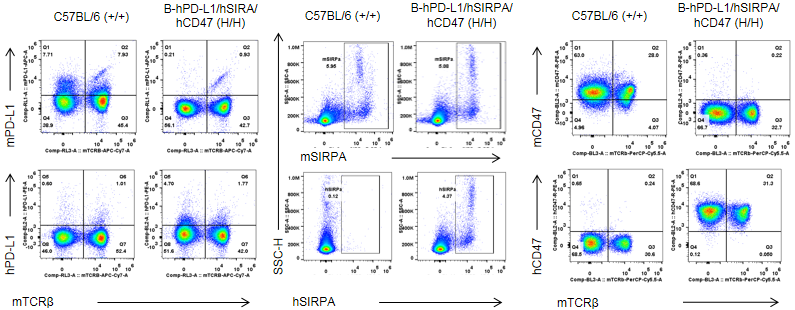
Strain specific PD-L1, CD47 and SIRPα expression analysis in homozygous B-hPD-L1/hSIRPA/hCD47 mice by flow cytometry. Splenocytes from both wild type (+/+) C57BL/6 and homozygous B-hPD-L1/hSIRPA/hCD47 (H/H) mice were analyzed by flow cytometry. Mouse PD-L1+ and CD47+ T cells were only detectable in the WT C57BL/6 mice. Human PD-L1+ and CD47+ T cells were only detectable in the homozygous B-hPD-L1/SIRPA/hCD47 mice. Mouse SIRPα was detectable in WT mice. This anti-mouse SIRPα antibody also reacts crossly with hSIRPα. Human SIRPα were exclusively detectable in homozygous B-hPD-L1/hSIRPa/hCD47 mice but not in WT mice.
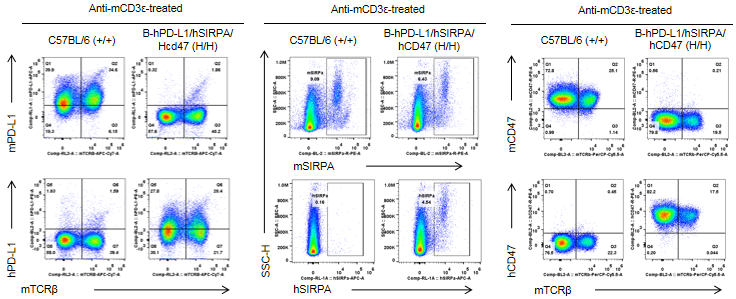
Strain specific PD-L1, CD47 and SIRPα expression analysis in homozygous B-hPD-L1/hSIRPA/hCD47 mice by flow cytometry. Splenocytes from both wild type (+/+) C57BL/6 and homozygous B-hPD-L1/hSIRPA/hCD47 (H/H) mice stimulated with anti-CD3ε in vivo, and analyzed by flow cytometry. Mouse PD-L1+ and CD47+ T cells were only detectable in the WT C57BL/6 mice. Human PD-L1+ and CD47+ T cells were only detectable in the homozygous B-hPD-L1/SIRPA/CD47mice. Mouse SIRPα was detectable in WT mice. This anti-mouse SIRPα antibody also cross reacts with hSIRPα. Human SIRPα were exclusively detectable in homozygous B-hPD-L1/hSIRPA/hCD47 but not WT mice.

Analysis of spleen leukocyte subpopulations by FACS. Splenocytes were isolated from C57BL/6 and B-hPD-L1/hSIRPA/hCD47 mice (n=3). Flow cytometry analysis of the splenocytes was performed to assess leukocyte subpopulations. A. Representative FACS plots. Single live cells were gated for CD45 population and used for further analysis as indicated here. B. Results of FACS analysis. Percent of T cells, B cells, NK cells, monocytes, DCs, granulocytes and macrophages in homozygous B-hPD-L1/hSIRPA/hCD47 mice were similar to those in the C57BL/6 mice, demonstrating that introduction of hPD-L1, hSIRPα and hCD47 in place of its mouse counterpart does not change the overall development, differentiation or distribution of these cell types in spleen.
Analysis of spleen T cell subpopulations in B-hPD-L1/hSIRPA/hCD47 mice
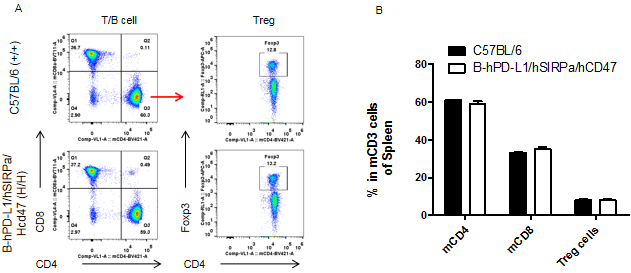
Analysis of spleen T cell subpopulations by FACS. Splenocytes were isolated from female C57BL/6 and B-hPD-L1/hSIRPA/hCD47 mice (n=3). Flow cytometry analysis of the splenocytes was performed to assess leukocyte subpopulations. A. Representative FACS plots. Single live CD45+ cells were gated for CD3+ T cell population and used for further analysis as indicated here. B. Results of FACS analysis. Percent of CD8+ T cells, CD4+ T cells and Treg cells in homozygous B-hPD-L1/hSIRPA/hCD47 mice were similar to those in the C57BL/6 mice, demonstrating that introduction of hPD-L1, hSIRPα and hCD47 in place of its mouse counterpart does not change the overall development, differentiation or distribution of these T cell subtypes in spleen.

Analysis of blood leukocyte subpopulations by FACS. Leukocytes were isolated from C57BL/6 and B-hPD-L1/hSIRPA/hCD47 mice (n=3). Flow cytometry analysis of the splenocytes was performed to assess leukocyte subpopulations. A. Representative FACS plots. Single live cells were gated for CD45 population and used for further analysis as indicated here. B. Results of FACS analysis. Percent of T cells, B cells, NK cells, monocytes, DCs, granulocytes and macrophages in homozygous B-hPD-L1/hSIRPA/hCD47 mice were similar to those in the C57BL/6 mice, demonstrating that introduction of hPD-L1, hSIRPα and hCD47 in place of its mouse counterpart does not change the overall development, differentiation or distribution of these cell types in blood.
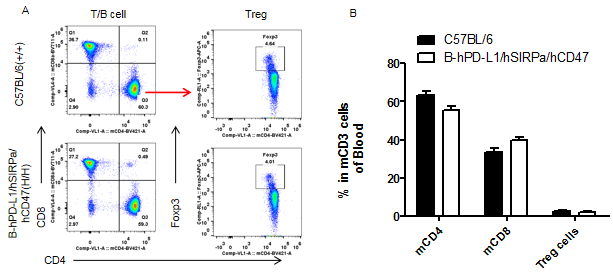
Analysis of blood T cell subpopulations by FACS. Leukocytes were isolated from female C57BL/6 and B-hPD-L1/hSIRPA/hCD47 mice (n=3). Flow cytometry analysis of the splenocytes was performed to assess leukocyte subpopulations. A. Representative FACS plots. Single live CD45+ cells were gated for CD3+ T cell population and used for further analysis as indicated here. B. Results of FACS analysis. Percent of CD8+ T cells, CD4+ T cells and Treg cells in homozygous B-hPD-L1/hSIRPA/hCD47 mice were similar to those in the C57BL/6 mice, demonstrating that introduction of hPD-L1, hSIRPα and hCD47 in place of its mouse counterpart does not change the overall development, differentiation or distribution of these T cell sub types in blood.
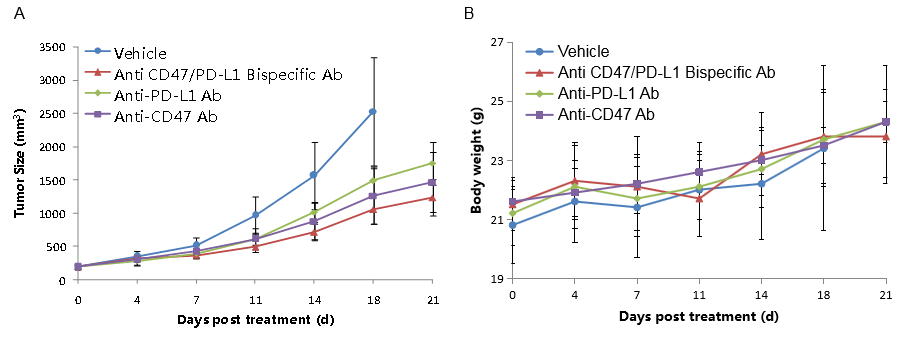
Antitumor activity of anti-human CD47/PD-L1 bispecific antibodies in B-hPD-L1/hSIRPA/hCD47 mice. (A) Anti-human CD47/PD-L1 bispecific antibody inhibited MC38-hPD-L1-hCD47 tumor growth in B-hPD-L1/hSIRPA/hCD47 mice (female, 6-8 week-old, n=5). Mice were grouped when tumor volume reached approximately 200 mm3, at which time they were treated with different antibodies with doses and schedules indicated in panel. (B) Body weight changes during treatment. As shown in panel A, the bispecific antibody showed better efficacy among these antibodies, demonstrating that the B-hPD-L1/hSIRPA/hCD47 mice provide a powerful preclinical model for in vivo evaluation of anti-human CD47/PD-L1 bispecific antibodies. Values are expressed as mean ± SEM.
Note: All antibodies used in this experiment are sourced from the client.









